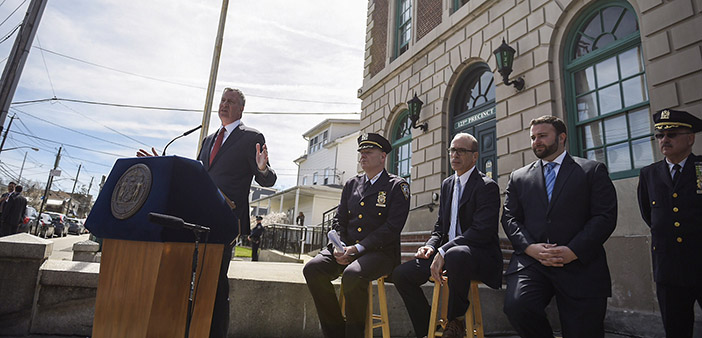Photo Courtesy of Ed Reed/Mayoral Photography Office
“The preliminary results are in: Neighborhood policing works,” said Mayor de Blasio.
By Michael V. Cusenza
“The preliminary results are in: Neighborhood policing works.”
Mayor Bill de Blasio on Monday, joined by City Police Department brass, trumpeted the NYPD’s pivot to a community relations-based policing model as a rousing success.
“Neighborhood policing has ushered in a new era of law enforcement built on mutual trust, understanding and cooperation. When New Yorkers know their local officers and trust their local officers, we are all safer as a city,” de Blasio said. “Coupled with the retraining of the entire department and the introduction of body cameras, we’re giving officers the tools they need to do their jobs effectively and strengthening the bonds between police and community to make the safest city in the nation even safer.”
According to the City, for the first quarter of 2017, neighborhood policing commands experienced a 6.2-percent decline in the seven major felony offenses (murder and non-negligent manslaughter, rape, robbery, felony assault, burglary, grand larceny and grand larceny of a motor vehicle) when compared to the first quarter of 2016. This means there were approximately 800 fewer major crimes committed in the neighborhood policing commands – and more people in these communities were protected from the pain and disruption caused by violent crime victimization. Non-neighborhood policing commands also experienced reductions in serious felony crimes, but at a lower rate with 450 fewer of the seven major felony offenses committed in the first quarter of 2017 as compared to 2016.
As Police Commissioner Jim O’Neill explained last year, when the department began its gradual rollout of the strategy, the Neighborhood Policing Plan, which is now in place in more than 50 percent of NYPD precincts, divides precincts into four or five fully staffed sectors that correspond, as much as possible, to the boundaries of actual existing neighborhoods. Sector officers assigned to these sectors work the same neighborhoods on the same shifts, increasing their familiarity with the local residents and local problems. The radio dispatchers, supervisors, and sector officers work together to maintain “sector integrity”: the sector officers and sector cars do not leave the boundaries of their assigned sectors, except in genuine emergencies. The plan seeks to foster a sense of ownership among sector officers for the people, the problems, and even the perpetrators in a particular sector; a sense of geographic responsibility and accountability, O’Neill said.
Supporting the sector officers and filling out each sector team are two cops designated as the neighborhood coordination officers. The NCOs are conceived as liaisons between the police and the community, but also as key crime-fighters and problem solvers in the sector, according to O’Neill. While they answer some radio calls to keep them conversant with the daily workload, the NCOs spend more time actively familiarizing themselves with the community to better respond to neighborhood-specific crime and other conditions. The NCOs immerse themselves in the community by attending meetings with community leaders and clergy, visiting schools, following up on previous incidents, and using creative techniques and adaptive skills to fight crime unique to their particular sectors.
“The release of this report demonstrates the substantial progress we have made in reducing crime and building trust in neighborhood policing commands,” O’Neill added. “This new philosophy will enable us, by working collectively with the public, to further reduce crime and keep New York the safest city in America.”

